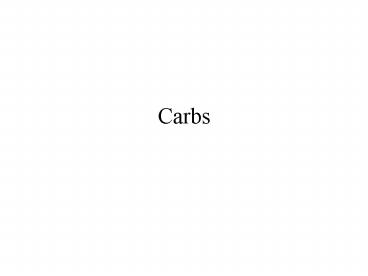Carbs - PowerPoint PPT Presentation
1 / 37
Title:
Carbs
Description:
Carbs. Greatest biomass of biopolymers. Polyhydroxy aldehydes and ... Next-to-bottom carbon hydroxyl extends to the right --- a D sugar; cf. ... stereo ... – PowerPoint PPT presentation
Number of Views:43
Avg rating:3.0/5.0
Title: Carbs
1
Carbs
2
Carbohydrates
- Greatest biomass of biopolymers
- Polyhydroxy aldehydes and ketones
- Many functions
- Structure
- Fuel
- Energy storage
- Adhesion
- Lubrication
- signalling
- tagging for siting, function
3
Degree of polymerization
- Monosaccharides
- Storage, energy modules, metabolic intermediates
- Disaccharides, trisaccharides
- Storage
- Oligosaccharides
- Molecular Recognition
- Polysaccharides
- Structure, storage
4
Fisher Projectionsof chiral monosaccharides
- Next-to-bottom carbon hydroxyl extends to the
right --- a D sugar cf. with L amino acid
5
fig 9-3a
6
fig 9-3b
7
Hemiacetal/-ketal structures of monosaccharides
- Reaction of an aldehyde or ketone with an alcohol
- favorable intramolecular reaction
8
fig 9-5
9
Intramolecular hemiacetals/ketals of
monosaccharides are RINGS
stereo
chair
open chain
Haworth
10
Anomers
- Sugars that vary in configuration about the
anomeric (aldehydic or ketonic) carbon - Convention ? hydroxyl down,
- ? hydroxyl up
11
fig 9-6
12
Fig 9-7
13
Hexose derivatives
- Amino sugars
- Acetamido sugars
- Deoxy sugars
- Fucose, rhamnose, abequose
- Other glycosidic additives
- Lactic acid
- Oxidized sugars
- Sugar phosphates
14
Fig 9-9
15
Reducing sugars
- Aldehydes are oxidized by mild agents
- Cu2 aldehyde (or ?-hydroxyketone) ? Cu
acid - Disaccharides react more slowly
16
Fig 9-10
17
Disaccharides
- Glycosidic linkage
- Acetal (or ketal) formed. 2nd monosaccharide
acts as an alcohol
18
Fig 9-5 (repeat)
19
Disaccharide, cont
- Reducing
- one anomeric C not glycosidically linked
- Nonreducing
- Both anomeric Cs linked (fructose, trehalose)
20
Disaccharide nomenclature
- Nonreducing end on left
- Linkage (n?m)-
- Reducing end
- Note that nonreducing end configuration is fixed
- Reducing end can mutarotate, thus 1st component
given as ?- or ?-, 2nd ambiguous (next slide)
21
Fig 9-11
22
Table 9-1
23
Important disaccharides
- Maltose
- Lactose
- Sucrose
- Trehalose
24
Fig 9-12
25
Table 9-2
26
Storage polysaccharides
- Plants
- Starch
- Amylose llinear polyglucose, ?-1,4 linked
(?-D-glucopyranosyl-(1?4)-), M 106 - Amylopectin polyglucose, ?-1,4 linked, ?-1,6
branched 1 per 24-30, M 108 - Animals
- Glycogen
- polyglucose, ?-1,4 linked, ?-1,6 branched 1 per
24-30, M 106
27
Fig 9-15 b
28
Fig 9-14
0.10 ?m
1.0 ?m
29
fig 9-15
30
Structural Polysaccharides
- Plants
- Cellulose linear polyglucose
- ? 1,4 linked
- M 106
- Certain exoskeletons
- Chitin linear poly(N-acetyl-D-glucosamine)
- ? 1,4 linked
31
Fig 9-17a and 9-18
Cellulose
Chitin
32
Structural polysaccharides, cont
- Bacterial cell walls peptidoglycans
- Extracellular matrix of multicellular animals -
glycosaminoglycans
33
Fig 9-19
34
Fig 9-20
35
Sugar-protein and sugar-lipid conjugates
- Glycoconjugates
- Proteoglycans
- Glycosaminoglycans bound to proteins
- Glycoproteins
- Oligosaccharides bound to proteins
- Glycolipids
- Oligosaccharides bound to lipids (heads of
membrane lipids)
36
Fig 9-29
37
Fig 9-27































